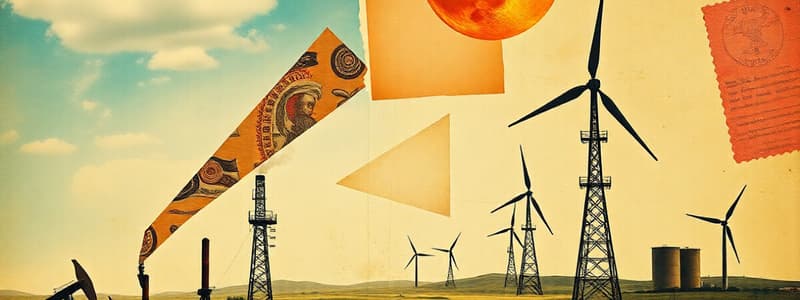Podcast
Questions and Answers
What common disadvantage do fossil fuels and biomass share?
What common disadvantage do fossil fuels and biomass share?
- Emission of carbon dioxide (correct)
- Dependence on weather conditions
- High cost of extraction
- Limited availability
Which of the following energy resources is classified as non-renewable?
Which of the following energy resources is classified as non-renewable?
- Hydrogen Fuel Cells
- Wind Energy
- Solar Energy
- Fossil Fuels (correct)
What process is used to separate products such as diesel and octane from petroleum?
What process is used to separate products such as diesel and octane from petroleum?
- Fractional distillation (correct)
- Thermal cracking
- Hydraulic fracturing
- Distillation
Which alternative fuel produces only water when burned for energy?
Which alternative fuel produces only water when burned for energy?
What is one major disadvantage associated with the use of nuclear energy?
What is one major disadvantage associated with the use of nuclear energy?
Flashcards
Fractional Distillation
Fractional Distillation
A process that separates different components of petroleum based on their boiling points, resulting in products like diesel, octane, and other fuels.
Biomass
Biomass
A fuel source derived from organic matter, like wood, crops, or waste, that can be burned for energy.
Geothermal Energy
Geothermal Energy
A type of energy derived from the heat within Earth's core. It's a renewable resource as long as the Earth's core remains hot.
Hydrogen Fuel Cells
Hydrogen Fuel Cells
Signup and view all the flashcards
Nuclear Energy
Nuclear Energy
Signup and view all the flashcards
Study Notes
Fossil Fuels and Biomass Disadvantages
- Fossil fuels and biomass share a common disadvantage: they produce carbon dioxide.
Element with High Energy
- Uranium-235 has three million times the energy of the same amount of coal.
Electricity Production from Fossil Fuels
- 85% of US electricity is generated using fossil fuels.
Examples of Fossil Fuels
- Petroleum
- Natural gas
- Gasoline
- Oil
Petroleum Processing
- Fractional distillation is used to process petroleum into diesel, octane, and other products.
Energy Resources and Renewability
| Energy Resource | Renewability |
|---|---|
| Fossil Fuels | Non-renewable |
| Nuclear Energy | "It depends" |
| Solar Energy | Renewable |
| Hydroelectric Energy | Renewable |
| Wind Energy | Renewable |
| Geothermal Energy | Renewable |
| Hydrogen Fuel Cells | Renewable |
| Biomass | Renewable |
Biomass Composition
- Biomass includes wood, soy, corn, and rice hulls.
Hydrogen Fuel Cells' Advantage and Disadvantage
- Advantage: Produces only water as a byproduct when burned for energy
- Disadvantage: Expensive to produce, requires a lot of energy
Nuclear Fuel Advantages and Disadvantages
- Advantage: Produces zero carbon dioxide or other greenhouse gas emissions.
- Disadvantage: Produces radioactive waste.
Geothermal Energy Source
- Geothermal energy is derived from heat within the Earth.
Studying That Suits You
Use AI to generate personalized quizzes and flashcards to suit your learning preferences.
Description
This quiz covers the disadvantages of fossil fuels and biomass, along with a comparison of various energy resources. Explore the impact of these resources on electricity production and their renewability aspects. Test your knowledge on the composition of biomass and the processing of petroleum.




